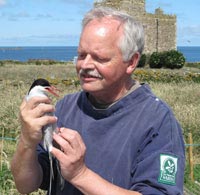
Released
on: September 29, 2010, 4:05 am
Author: National Trust
Industry: Environment
National Trust reports that an Arctic tern discovered off the coast of Northumberland is believed to be more than 30 years-old, making it the oldest known in the UK.
Originally ringed on the Farne Islands on 28 June 1980, it was re-trapped on Inner Farne this summer. The bird would have been ringed when a few days old making it now more than 30 years of age.
 The
tern was trapped in 1980 by a team of wardens that included John Walton who
is now the National Trust property
manager for the islands.
The
tern was trapped in 1980 by a team of wardens that included John Walton who
is now the National Trust property
manager for the islands.
John Walton said: "This is a remarkable discovery especially as only one-in-50 birds that are ringed are subsequently caught again.
"Back in 1980 I was in my second year as a seasonal warden. Part of my job was ringing tern chicks. When I put ring number CE60645 onto the chick's leg and recorded it in the log I thought no more of it. It was one of hundreds that would make the perilous journey down to the Antarctic that winter.
"When the news broke regarding the tern I was out like a shot to see how CE60645 had fared. This bird will have flown close to one million miles, raised any number of chicks, survived predators and storms and still looks in brilliant shape.
"In contrast, I have led a relatively sedentary existence and kept adventure to a sensible level, in fact alongside the tern I look knackered."
The previous British record for the oldest Arctic Tern was 29 years, 10 months and 11 days which was also discovered on the Farne Islands.
An estimated 2,199 pairs of Arctic tern spent the summer months on the Farne Islands this year compared to around 3,129 pairs that made up the population in 1980. The decrease in numbers counted is largely down to a colony shift.
Lee Barber, Recoveries Officer at the British Trust for Ornithology, said: "This is a great record but something we wouldn't have known about if this bird hadn't been ringed.
"Without this uniquely numbered ring, we really would have little knowledge of how long Arctic terns live and breed.
"This highlights the importance of ringing as a tool for conservation which allows us to identify birds as individuals. Let's hope Arctic Tern CE60645 returns to the Farne Islands next year and breaks its own record."
The Arctic tern was recently discovered to have the longest migration route of any animal, flying an estimated 44,000 miles between breeding grounds in Greenland to Antarctica in an 'S' shape to take advantage of prevailing global wind systems in order to preserve energy.
David Steel, head warden on the Farne Islands, added: "The oldest known Arctic tern is a 34 year-old American so it would be nice to see this bird, one day, claim the record – watch this space."
-ends-
Notes to editors:
About
the National Trust:
The National Trust is one of the most important nature conservation organisations
in Europe with over 1,000 sites covering 250,000 hectares, including coastal
sites, woodland and upland areas; many of which are rich in wildlife and provide
opportunities for days
out for families. All 17 species of UK bat have been recorded as roosting
or breeding on National Trust land and 96 per cent of all resident UK butterflies
can be found on its land. Wicken Fen in Cambridgeshire is the trusts most species
rich site and 93 per cent of its land has been surveyed for its nature conservation
importance.
More
than 30 different outdoor days
out in the UK from canoeing to surfing and rock climbing to walking take
place on National Trust land. With more than 250,000 hectares of countryside
and 710 miles of coastline across England, Wales and Northern Ireland there
are plenty of places
to go and opportunities to enjoy the great outdoors with the National Trust.
For
further press information please contact:
Steve Field
Assistant Press Officer
The National Trust
Kemble Drive
Swindon
SN2 2NA
01793 81 7740
An ISDN audio line is available
www.nationaltrust.org.uk